Verdict
The Garmin Forerunner 265s is a great multisports watch with an even lovelier display than the 255, but that screen and some other software extras do come at significantly greater price.
Pros
- Vibrant and high quality AMOLED display
- Solid sports tracking performance
- Still strong battery life
Cons
- It’s more expensive than 255
- No cheaper music-free model
-
Made for smaller wrists:The 265s uses a 42mm case -
AMOLED display with always-on option:A step up from Garmin’s old transflective display -
Multiband GPS mode and Sat IQ technology:The connection is optimised depending on your location
Introduction
The Garmin Forerunner 265s is the successor to what you can essentially call the middle member of the Forerunner watch family. It offers more advanced training metrics and features than the budget-friendly Forerunner 55, but lacks the richer mapping capabilities of the 965.
This is a watch for people who mainly run, but it will also cover some swimming, cycling and even indoor workout time with the key big difference between the 265s and the Garmin Forerunner 255 being the addition of an AMOLED display.
It joins Garmin’s Venu and Epix series watches by adding a splash of colour to better compete with sports tracking smartwatches like the Apple Watch 8 and Samsung Galaxy Watch 5. Garmin already has the sports tracking pedigree so has that added screen elevated the Forerunner to become one of the best sports watches and a worthy upgrade on the 255? Here’s our take.
Design and screen
- Slightly larger case size
- New AMOLED screen
- Redesigned workout button
- Swim-proof up to 50-metres
While the 265s retains that familiar sports watch styling, there are some changes on the looks front outside of that new display technology.
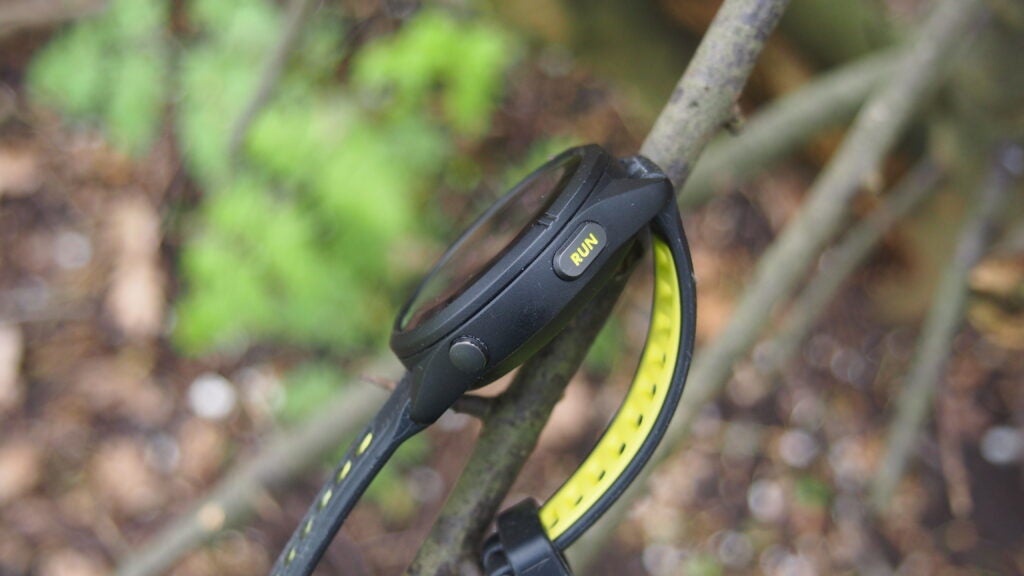
For starters, the 265s comes with a slightly larger case. It’s now 41.7mm as opposed to 41mm, while the bigger 265 sticks to a 46mm one. That doesn’t really change the s version from being a dinky little thing to wear and if you like your watches small and light then that’s what you get here.
It’s still an all polymer case with an 18mm quick-release silicone band that comes in three different colours and still feels as sporty as its predecessor. There’s five physical buttons with the main workout button now a larger, flatter button with the words ‘Run’ written across it to make it more distinguishable and easier to start/stop a workout.
The big story here is the display as Garmin swaps its go-to transflective display technology for an AMOLED one. It’s a 1.1-inch, 360 x 360 resolution screen that does offer an always-on mode and also has nicely responsive raise to wake gesture support. That screen is toughened up with Corning Gorilla Glass 3 like its predecessor and while it’s the same size screen as the one featured on the 255, the experience of looking at it and interacting with it certainly is different in a positive way.
It’s a small screen, but it’s a vibrant one. It’s got those lovely deep blacks and rich, accurate colours that you associate with high quality AMOLED panels and it just feels great to look at. Viewing angles and visibility in bright outdoor light haven’t been a major issue either, although it doesn’t surpass what you’ll get from a transflective display from a visibility point of view. The touchscreen support feels slick and it feels like a good addition here overall.
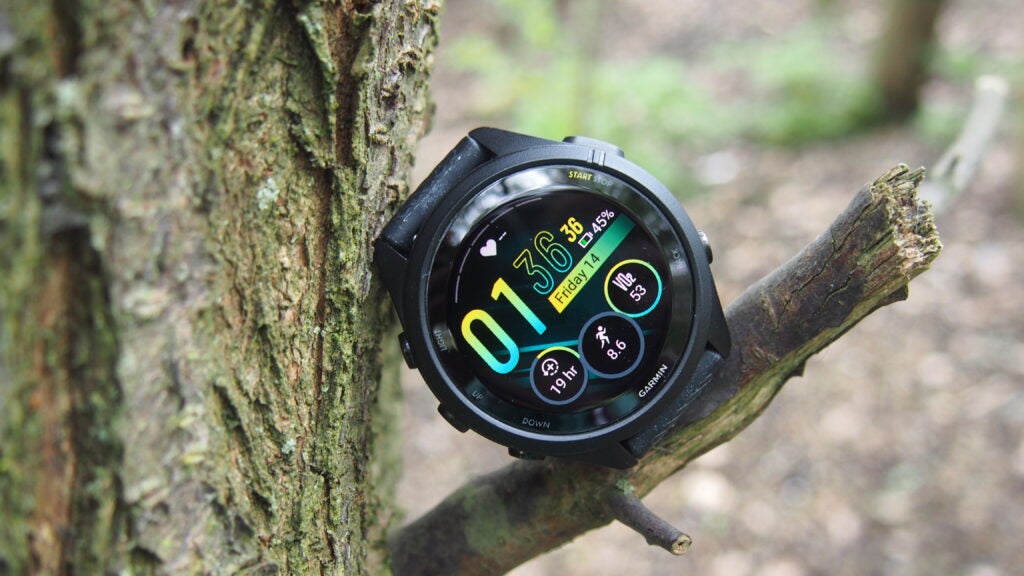
There are no surprises on the waterproofing front. Garmin sticks to a 5 ATM rated design, which means you can keep it on in the shower and you can put it to the test during pool and open swimming.
Software and smartwatch features
- New UI
- Morning Report
- Garmin Pay and music player on all models
Before getting into its sports tracking credentials, it’s worth highlighting the software experience on the 265s because along with a colour screen, Garmin has tinkered with the watch UI. It’s best described as a mix of the UI featured on its Venu series and pricier Epix watches, where features like Garmin’s Glances (widgets) stream or shortcut settings are a swipe or a button press away.
The UI animations have certainly been bolstered and that’s noticeable on features like Garmin’s quite handy Morning Report feature where it’ll tell you how good or bad your sleep was, suggest workouts for the day, pull up key calendar appointments and can be customised to show the data you’d find useful first thing in the morning.
Smartwatch features in general have remained largely the same as the 255, but you are getting 8GB as opposed to 4GB of built-in storage and now offline music playback comes as a standard feature across all models where previously you could save some money by ditching it with the 255.
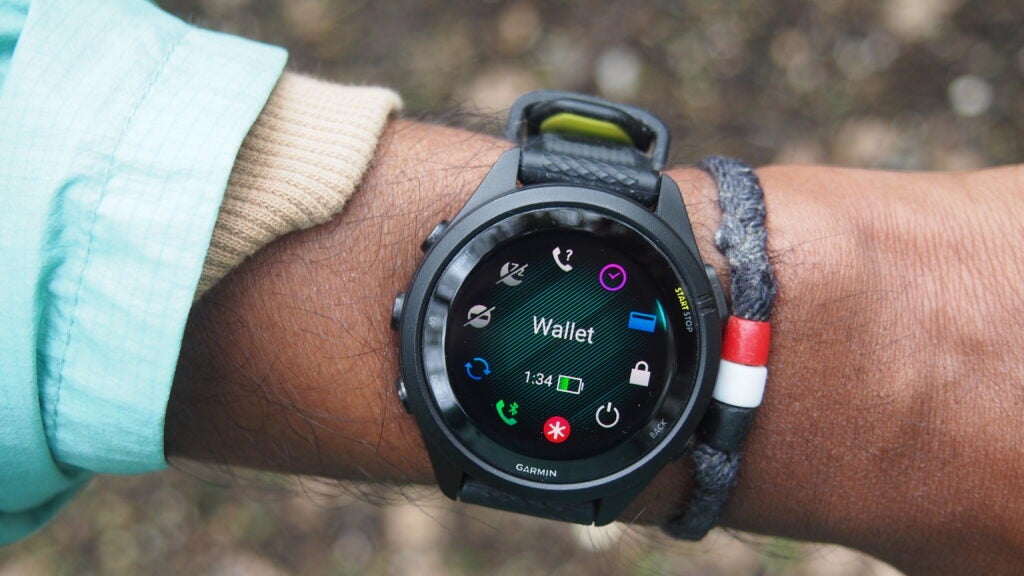
The experience of using the 265s as a smartwatch really depends on what features you value. If you’re going to mainly use it to view phone notifications and for controlling and streaming music, then it does those types of things well. It does include Garmin Pay and you do have access to Garmin’s Connect IQ Store, but these aren’t really the strengths of Garmin’s smartwatch ecosystem. It’s absolutely not an Apple Watch or a Samsung Galaxy Watch in terms of the overall experience, but the core features work well and it certainly does mean that the 265s is useful to have on when it’s not tracking your workout.
Fitness tracking
- Training Readiness added
- Sat IQ technology and multiband GPS
- 30+ sports apps
Like all of Garmin’s Forerunner watches, run tracking is the primary focus but it’s equipped to track a lot more activities. Cycling and swimming are also core modes, but it’s equipped to track indoor workouts like rowing and the Elliptical, and it has profiles for skiing and snowboarding. The watch does include a dedicated triathlon mode as well, which hasn’t been the case in the past.
Running is the main reason why you’d want to buy it though and from that point of view, it’s pretty much everything you could want in a running watch. It’s nice and light to run with, the screen is easy to view your real-time stats, customise them and crucially, those stats are reliable too.
The running features though are largely the same as what we got on the 255. That includes Garmin’s new Sat IQ technology and multiband GPS to make sure you’re using the best GPS tracking option based on your environment, and that you’ve got your watch set to account for more challenging GPS signal environments. I’ve used it on a lot of the same types of runs I’ve used for other Garmin watches with that same multiband mode and it’s performed well, particularly against the also very excellent Apple Watch Ultra and Garmin’s own Forerunner 965.
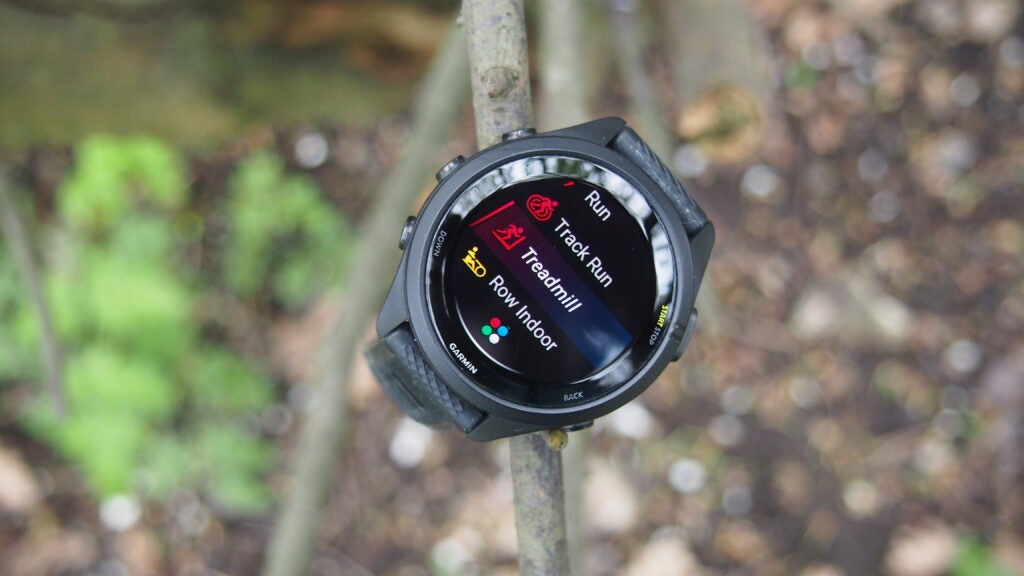
It’s been a similar story for activities like swimming and indoor workouts like treadmill running and indoor rowing sessions that I strapped it on for. Initial tracked treadmill runs weren’t wildly inaccurate like they often can be and you can of course calibrate the watch to make sure it’s more accurate for future runs.
The other big aspect here is how you can use the 265s as a training companion and it has everything the 255 offered on that front. It works with Garmin Coach to sync running-focused workouts to the watch. You can upload routes, but you’ll only get the breadcrumb-style navigation as opposed to the fuller mapping support you’ll get on pricier Garmins. There’s the much improved race predictor and useful PacePro pacing strategies and analysis like VO2 Max, acute load and training effect data for those who want those more hardcore metrics.
The big one that I’m glad to see is Training Readiness. This is a heart rate variability-based insight that was added on other Garmin watches in 2022, but bizarrely didn’t make it to the 255. Instead, Garmin added HRV Status, which fuels that Training Readiness insight, but feels more vague as a metric in isolation. With Readiness added, you’re getting a score based on other data points like sleep quality, recovery and training load to better understand whether you should train or take it easy.
After an injury, I tried to push it quite hard right after and the watch told me my training readiness was low and to take it easy. It could see I hadn’t trained much and my sleep hadn’t been great either, and I had a better idea of what choices I should make for that day.
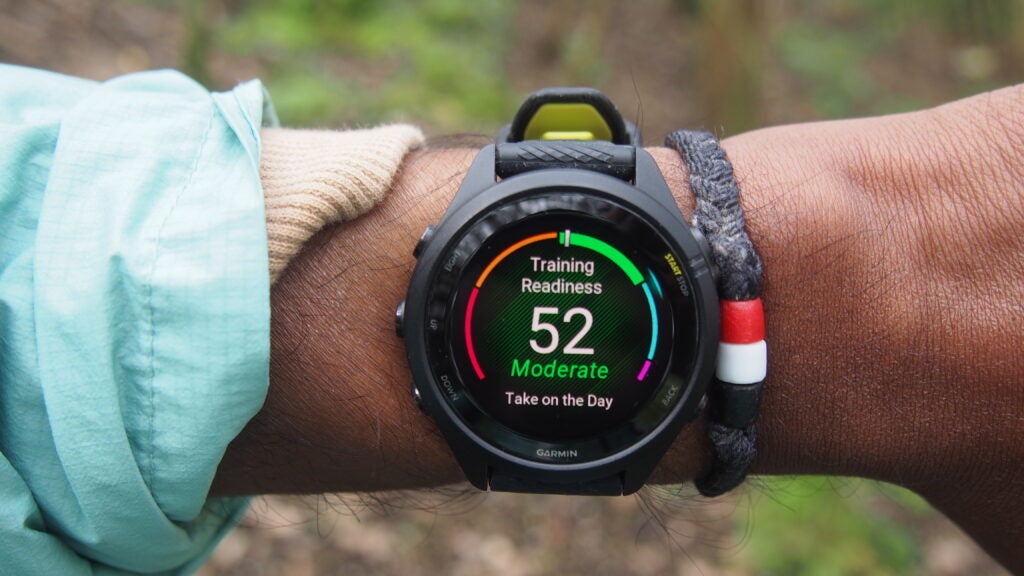
Like a lot of the insights here, they’re reliant on the tracking and the accuracy of those onboard sensors. I’d say that metrics like heart rate and sleep have been very good in general for me. The smaller form factor of the 265s definitely helps on that front to get a good reliable fit for day-to-day use and more rigorous workout time like interval workouts.
What you get on the 265s is a good mix of tracking and analysis, with scope to go heavy or light and put some trust in Garmin’s guidance to help you do the right things. Outside of Training Readiness however, it’s not hugely different from what you get on the Forerunner 255.
Battery life
- Up to 15-days in smartwatch mode
- Up to 24-hours GPS battery life
- Up to 15-hours in top multiband GPS mode
With the addition of a power-hungry AMOLED screen there’s understandably going to be some concerns about the level of battery life you can expect from the 265s.
The good news is that the battery performance in general has been very good and should be able to cover a solid week of training while using features like notifications and music streaming – that is if you choose not to have the screen set to always-on mode. If you do, then it’s going to be less.
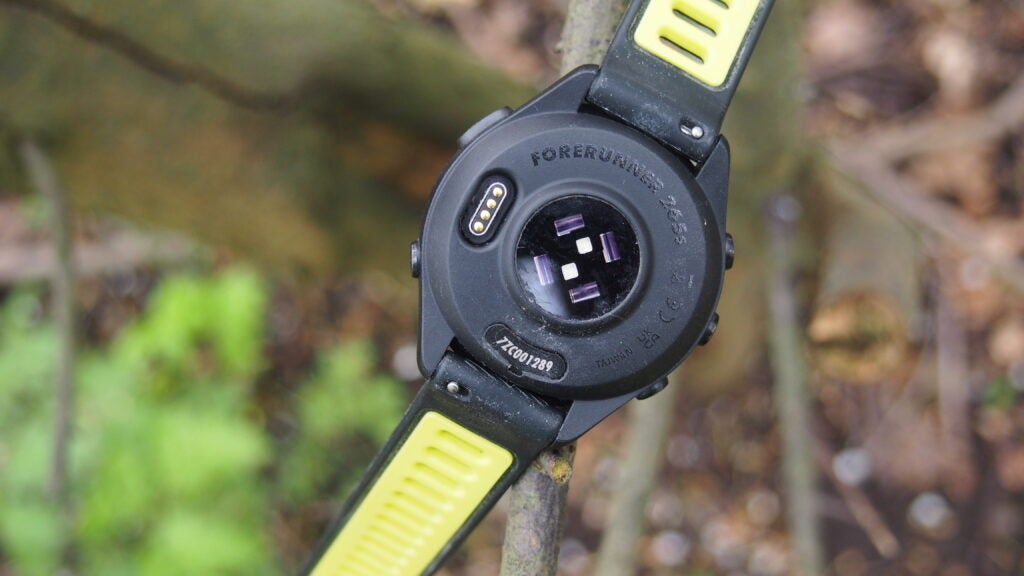
Garmin quotes a maximum of 15-days in smartwatch mode, which is up 3-days from the 255s. With the screen set to always-on, it drops to a maximum of 5-days and depending on how much activity you’re tracking, it’ll be less than that.
The battery drop-off when using the optimal GPS tracking mode compared to the more standard GPS mode is roughly about the same as what I’ve experienced on other Garmin watches. Just under an hour of running with the multiband mode in use saw the battery drop by 6%. Using the watch in multiband mode sees battery drop to 15-hours compared to 24-hours in the standard mode, which means you’ll see it drop by a few more percent during an outdoor workout.
This is a Garmin that doesn’t suffer badly with that added AMOLED screen. It should satisfy most who aren’t expecting it to last weeks and months like Garmin’s top-end Forerunner, Fenix and Epix watches.
Should you buy it?
You want a great sports watch with a lovely colour screen: Garmin takes the 255 and merges it with a great colour screen to make it a more desirable watch to own.
You don’t care about a colour screen: That AMOLED display and features like Training Readiness comes at a considerable extra cost over the 255.
Final Thoughts
The Garmin Forerunner 265s continues a positive trend of Garmin showing it can add great colour displays to its watches without making big sacrifices on battery life. If you’ve already got the 255, then colour screen aside, there’s not a massive amount of new software features to jump ship for. If you’ve been waiting for a Forerunner with a colour screen and you’re willing to pay for it, you’ll like what the 265s has to offer.
For anyone after a more stylish watch with Garmin’s usual fitness tracking features, you might want to check out the Garmin Vivomove Trend, while the Garmin Forerunner 955 is still a great option for serious runners.
FAQs
The Garmin Forerunner 265s cannot display full colour maps but does offer the ability to upload routes and follow simpler breadcrumb-style navigation.
Yes, the Forerunner 265 can be worn in the shower and carries a 5ATM rating, making it suitable to be submerged in water up to 50-metres depth.
Sustainability
TrustedReviews’ holds the fact that global warming is not a myth as a core value and will continuously endeavor to help protect our planet from harm in its business practices.
As part of this mission, whenever we review a product we send the company a series of questions to help us gauge and make transparent the impact the device has on the environment.
We currently haven’t received answers to the questions on this product, but will update this page the moment we do. You can see a detailed breakdown of the questions we ask and why in our sustainability info page.
Jargon buster
BPM
An abbreviation of ‘beats per minute’, used to describe the pace of someone’s heartbeat as recorded by a smartwatch or some other wearable.
GPS
An abbreviation of the Global Positioning System, which uses satellite communication to pinpoint your location. Some smartwatches are able to achieve this communication without the use of a smartphone.
















